Text
Suffer Little Children...Come Unto Me
"Sword of Light"
Part 2
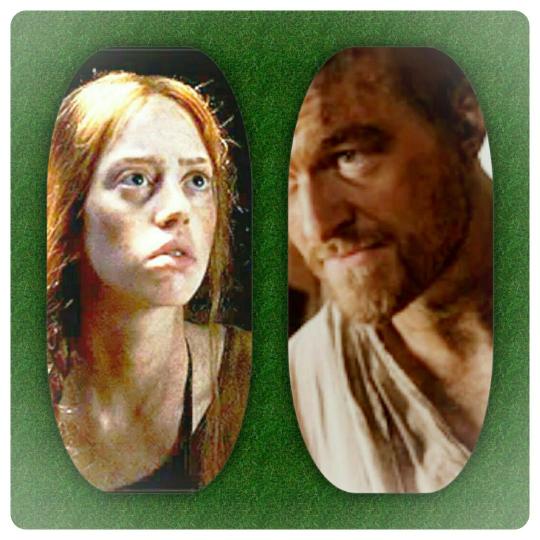
"Suffer Little Children": Chapter 3/?
"It had been three days since Gawain had awakened. But It had been six days since Gawain had died."
#cursed wheeler#cursed netflix#cursed fanfic#cursed pym#cursed gawain#gawain cursing#AO3#Saigh writes
2 notes
·
View notes
Text
Suffer Little Children...Come Unto Me
"Sword of Light"
Part 2

"Suffer Little Children": Chapter 2/?
"...he was already burning..."

#cursed netflix#cursed wheeler#cursed fanfic#cursed faith#cursed lancelot#cursed squirrel#AO3#Saigh writes
0 notes
Text
Suffer Little Children...Come Unto Me
"Sword of Light"
Part 2
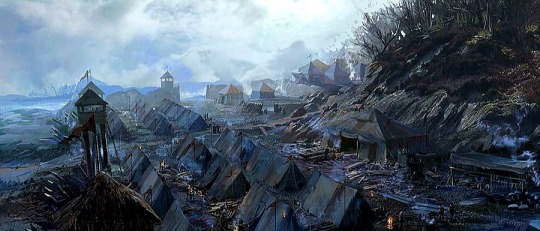
"Suffer Little Children": Chapter 1/?

0 notes
Text
Out of Darkness & the Shadow of Death
"Sword of Light"
Part 1
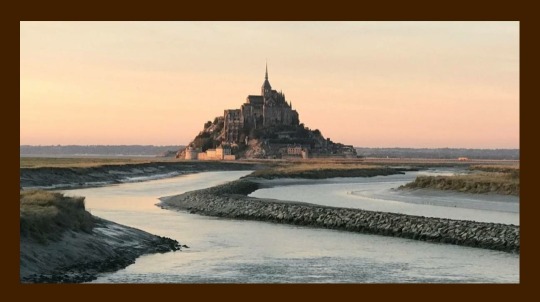
"Out of Darkness"
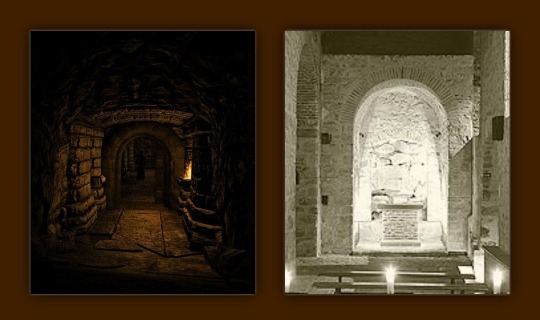
1 note
·
View note
Text
"You were Demon-Born, an Abomination in the Eyes of God...I gave you Scripture. I gave you Discipline"
(Salvation through Suffering: Atonement for the Sin of Existence)
Following Lancelot's deadly confrontation with the Trinity Guard, the injuries he incurred had a fair chance of being fatal without treatment. He would be looking at the likelihood not only of death, but of damnation after, either because Father Carden was right & he was damned by for the nature of his birth as well as his final defiance of Carden's teaching, or because Father Carden was wrong & he's damned all of the killing he perpetrated at Carden's direction. Either way, the extent to which he'd been religiously conditioned by his upbringing in Father's care wouldn't be something that would have just deprogrammed itself in the aftermath of fleeing the Paladin camp with Squirrel, especially with the likelihood of the damnation he'd slaughtered countless of his own kind to avoid seeming so imminent.
He would been afraid, whether he believed he deserved it or not. At whether he wished to or not, in his fear he very likely would have prayed. Below are a few select passages of Medieval Catholic Prayers in use by the 11th Century, which Lancelot might have been likely to say, paired with translations into English.
(verses in red are those he omitted from his recitation, prevented from saying them either for personal reasons or other factors)

"Do you love me, Father?...Even if I am damned?"
The show makes it devastatingly clear with this heartbreaking question - both in word & tone - how desperate the Weeping Monk is for the love & approval & comfort of a parental figure. It goes on to use the rest of the scene to confirm what the audience has already begun to suspect, that Carden had some time ago slaughtered the Ash Man's Fey Folk before indoctrinating/brainwashing Lancelot into a self-mutilating fear & hatred of his own Fey nature The book makes it even more clear than the show that Lancelot was - as the show strongly implies - a mere child when his own people were slaughtered, taken young enough that Carden was "the only Father he knew"
With no memory of his Fey parents, or of a mother's love & indoctrinated into a religion that condemned him for even existing, growing up he would likely have sought comfort in the idea of the benevolence of the Virgin Mother Mary watching over him.
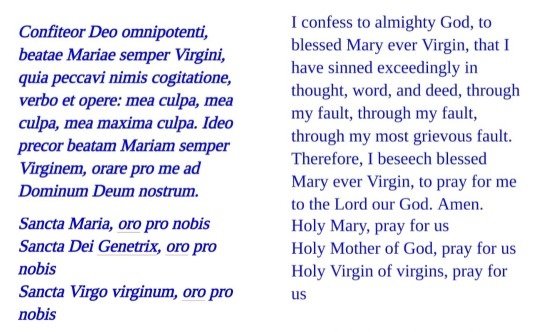
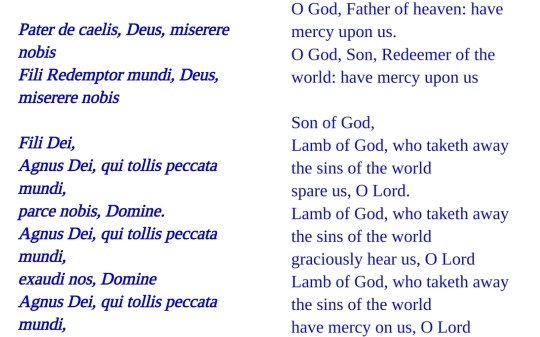
Once having begun a "confession", the ingrained servitude of his every act in Father Carden's name having been "penance" for the sin of his existence - an act of "contrition" for his "Demon Birth" that had been offered as his only means of "Redemption" - his psychological conditioning to beseech God's mercy would likely have beaten into him for so long he'd been unlikely to refrain from supplicating himself & begging for Salvation.

The Weeping Monk was conditioned to a belief that by the very nature of what he was born as, he was an abomination deserving of damnation. The foundation of Carden's control over him is a torturously ingrained conviction that his fundamental existence is that of the lowest & most vile of creatures, only raised above that dispicable state by Carden's teachings. Prayers Father Carden had him recite would no doubt have been ones that would reinforce that self-loathing.
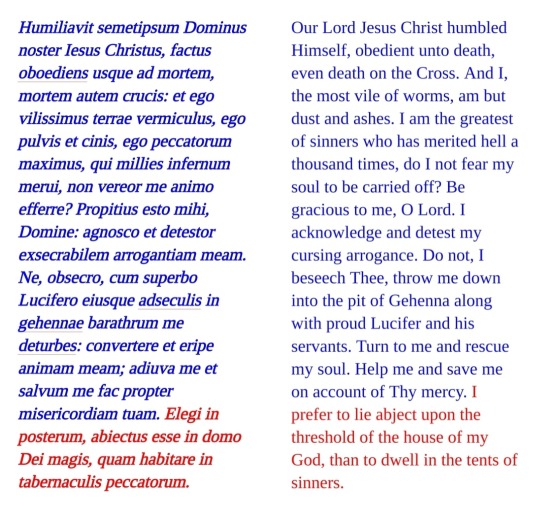
Once breaking free of the grip of his flashback & the prayers of self-debasement that had been beaten into him, he likely still would have reached out.
Just as Carden was the only Father he had known, so too had the Christian God been the only God he'd ever known. And despite how Carden had twisted it to his own purpose, many of Lancelot's actions had been out of what he had been mistaught was the way to show his love & devotion to that God.
In his final moments before acting, L'Ancelot "The Servant" likely would have prayed one last time to the God that he'd tried - in the only way he'd ever been shown - to serve. Not for forgiveness or absolution for sins that he knew he could not forgive himself for, but for the strength to face his fear & to accept his own Damnation willingly- not for the sake of wickedness, but for the sake of saving Squirrel.


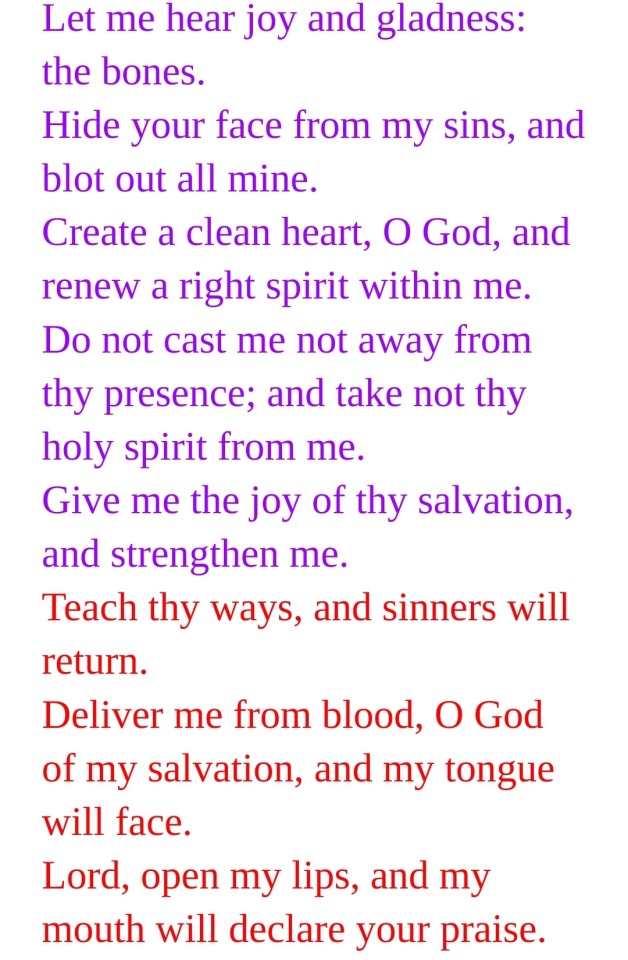

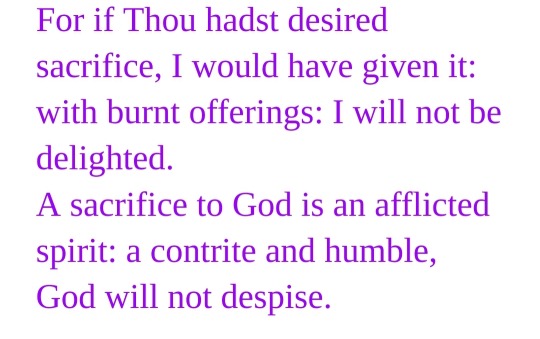
9 notes
·
View notes
Text
"Gawain took 'The Brass Shield'. It's the only ship the crosses the sea to the Desert Kingdom." "Yes, because nobody wants to go to the Desert Kingdom!"

Saljūqiyān-i Rûm
In the mid-1070s, Süleyman I successfully wrested control of Anatolia from the Byzantine rule of the Holy Roman Empire. Allowing the Greek-Byzantine populous to remain, under Seljuk Turk governance, he established the it as The Seljuk Sultanate of Rome. Though under Turko-Persian Sunni Muslim rulership, archeological & historical evidence indicates Jewish & Christian communities there were not only tolerated not only tolerated there prior to the onset of Crusader conquests beginning in 1096, but thrived. Süleyman's son Kilij Arslan I inherited his father's Sultanate in 1092.

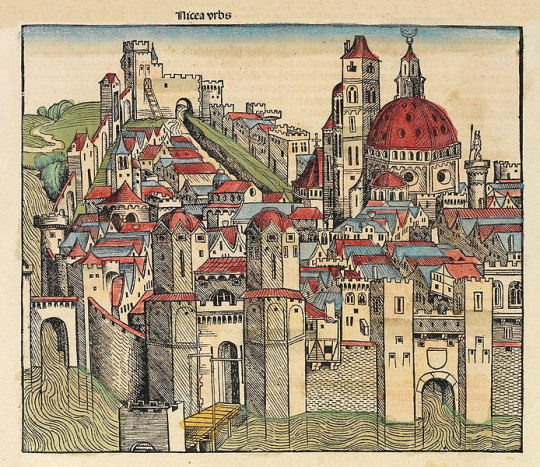
In 1096, infamous Crusader Monk 'Peter the Hermit' & his Lieutenant 'Walter the Penniless' led their notorious "People's Crusade" (estimated to have been anywhere between 30,000-60,000 strong) on a march of anti-semetic & anti-saracen slaughter & forced conversion from Germany to Constantinople, until they reached Saljūqiyān-i Rûm.
After crossing the Bosporus Strait from Byzantine Constantinople into Anatolia, the People's Crusade bagan making their way toward the nearby Saljūqiyān-i Rûm capital at Nicaea. On 21 October 1096, Kilij Arslan - only 17 at the time - met the People's Crusade army (estimated to have been had a remaining force - due to desertion & deaths from poor provisioning & sickness - of roughly 20,000) on the road to Nicaea with his own waiting army. The 17 year old Sultan not only effective repelled this initial attempted invasion into Muslim-held Anatolia, but he effectively crushed the "People's Crusade". It's historically noted those combatants who surrendered were spared if they agreed to convert to Islam (a requirement put in place only because the Christian Crusade invasion had been perpetrated specifically in the name of Religious Holy War). Women, children, elderly & infirm who had marched with the People's Crusade were also expressly spared; they were granted leave to either return to Europe or to remain and be granted amnesty. The rest of the invading force were slaughtered. Of the presumed 20,000 who marched against the Turkish capital, only an estimated 3,000 or so escaped and/or voluntarily returned to Byzantine Constantinople.
The charismatic leader of this zealous movement turned out to have been notably conspicuously absent from his army's devastating defeat, having briefly returned to Constantinople to resupply shortly prior to his Lieutenant leading the failed march against Nicaea. Upon hearing his forces had been wiped out in his absence, the Crusader Monk fled back to Western Europe to rebuild his religious following & resume his campaign against non-Christians a couple of years later.

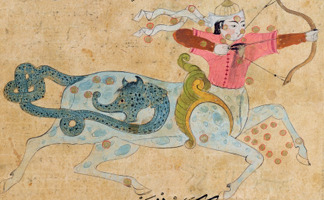

Parī (Peri) & Si'lat
Two classes of jinn from Persian lore, often considered relatively "benevolent" races of jinn in Turkish & Iranian Muslim Tradition.
Peri/Parī are most recognizable in their physical description as being winged, with a wide reputation for benevolent guidance & intercession on behalf of hunans.
Si'lat are frequently referenced in their natural form as somewhat resembling a greyhound lower body with a human upper body, but are noted to possess the ability to shape-shift & adopt human a human appearance. They're frequently credited with having knowledge surpassing that of humans. They're often mentioned in much folklore to have a fairly open-minded view regarding humans, however, being known to shape-shift into human form & live among them. They often insert themselves into human dilemmas, trying - because of their superior intelligence - to fix matters (to admittedly varying success).
*Sanctuary in the Desert Kingdom*
In the context of the 'Cursed'-verse and canon references to the possibility of the Desert Kingdoms as a considered destination for the Fey Refugees in Britain to seek asylum, the Turko-Persian historical reputation for religious tolerance might correlate to a hopeful assumption that the Muslim held region was likely to also be more tolerant of the Fey, as well as offer potential allies against their common Crusader & Vatican enemy.
*Djinn as Turko-Persian Fey Folk*
Still viewed in much Islamic folklore to be outright benevolent or largely non-malevolent classes of Djinn with a traditional reputation for a positive or open-minded view of humans & stories of attempts to intercede on their behalf, Peri & Si'lat are among the most likely regional "Fey" clans to have sought to render aid to innocent & displaced victims of the Crusades, regardless of species. Noted by folklore to also have been among the most intelligent of the Djinn, they are also two of the Clans most likely to have possessed alchemic, scientific, technical & medicinal skills with which to assist in treating wounded or defending against siege, as well as the willingness to share that knowledge with those in need.
1 note
·
View note
Text
"This is the TRUE Crusade. Not Jerusalem; right here. The Fey are the true enemies of God."
Although the book is set somewhat earlier in European history, Netflix version of 'Cursed' expressly conveys Carden's ire at the Fey & the Druids having "clung to power" in defiance of the Christian Church for "Ten Centuries" and directly references the Crusade in Jerusalem, firmly establishing the show's time-line as sometime between 1096-1099 (1101-1103 at the latest).
The characterization of Father Carden himself & his Red Paladin following bears striking parallels to a chilling historical real-life figure of the First Crusade & the movement he led through Europe in his campaign toward Jerusalem against those he deemed enemies of Christendom.

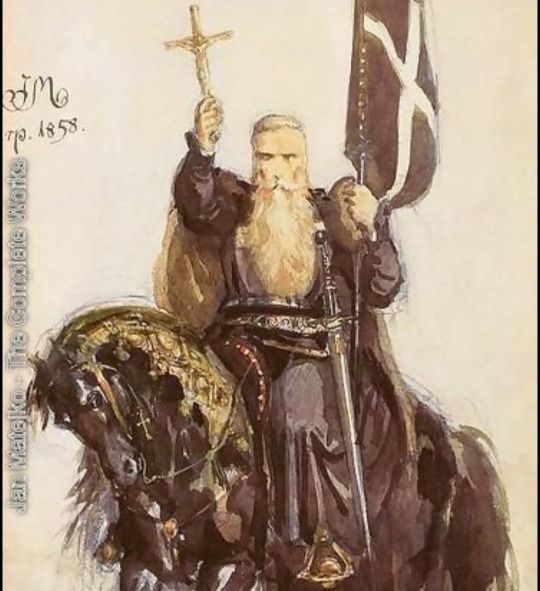

(Father Carden's Paladins & the People's Crusade of Peter The Hermit)
Held by historians to be one of the single most galvanizing instigators of the European Crusader fervor, Augustinian Monk Pierre l'Ermite ("Peter the Hermit") was a driving force in the religious Christian hysteria that lead up to the declaration by the Vatican in 1096 of the First Crusade to retake Jerusalem from Muslim control.
Long before the Pope's official pronouncement, the Monk was preaching among the poor & uneducated common populous throughout Europe, in an ongoing & inflammatory campaign against Non-Christians. One of his noteworthy claims used to incite the People's anger & fear was of having been not only barred by the Muslim Turkish rulers of Palestine from making an attempted religious Pilgrimage to Jerusalem, but of having been tortured by them. However, he was also documented during this time to have drummed up the devotion of his religious followers with claims to have received personal visitation from Jesus himself in Jerusalem instructing him to preach the calling of the Crusades. These direct contradictions are merely one example of conflicting claims made by him which contribute to many historians speculating that the entire claim of pilgrimage was a fabrication in total. His charismatic fervor & anti-islamic rhetoric, however, managed to gain him the zealous support of tens of thousands of disenfranchised commoners throughout England, Lorraine, France, and Flanders.
Constinsting of young & old, men women & children, armed with everything from swords & bows to pitchforks & rocks, armored mostly in Peter's pronouncements of "divine protection", he & his devout following of "Pauper Knighrs" amassed in Köln 12 April 1096.
Despite Vatican pronouncements that the target of the Christian Holy War was the Muslim Saracen rulership of Palestine, when undertaking their march to Reclaim The Holy Land "Peter The Hermit" & his "People's/Pauper's Crusade" spent the Spring & Summer of 1096 perpetrating & participating in the largest campaign of anti-semitic slaughter Europe had - up until that point - ever seen.

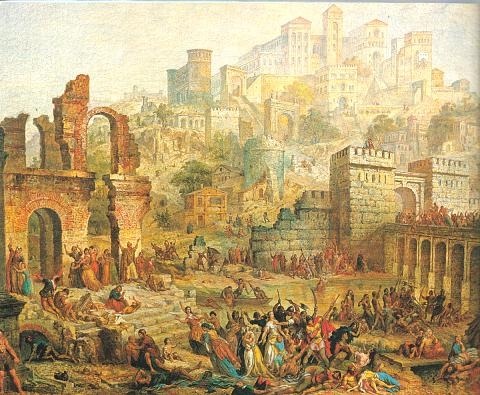
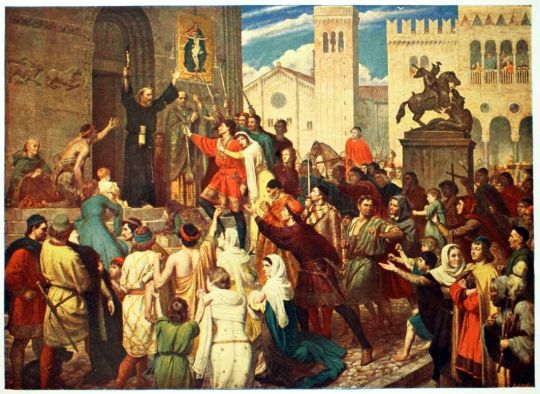
"You are aware the Red Paladins took this city first, are you not? And that Non-Christians were singled out, hung on stakes & burned to death."
(Rhineland Massacres)
The true claim to infamy of the "People's Crusade", the Rhineland Massacres, was a series of anti-semitic pogroms throughout Germany & France at the dawn of the First Crusade. Incited by the swelling support of anti-islamic rhetoric spreading throughout Europe, many swept up in the Crusader Fever saw it as carté blanch to turn their hatred on the nearest non-Christian targets at hand: the Jewish population.
The campaign of mass slaughter & torture-driven forced conversion was reported to have entailed such degrees of atrocity that there arose countless documented accounts of suicide rather than be subjected the horrific fate associated with falling into the hands of these Crusader bands.
Many of these pogroms were used as a cover for ransacking scapegoat communities in order to replenish their ill-prepared depleted provisions. The disorganized peasant Crusaders often arrived at such cities having run out of food & funds. To restock their supplies, they began to plunder Jewish food & property while attempting to force them to convert to Catholicism.
Some cities fearing pillaging from roving "Crusader" mobs merely stripped their Jewish communities of all lands & goods, ejecting them from their towns without food to starve or be slaughtered on the road. Even in cities where the local religious or secular government offered the Jews protection, Crusaders often defied such protections, such as in Mainz where they sacked the Archbishop's own palace after he sheltered the city's entire Jewish population behind the walls of its courtyard in an attempt to protect them. Other towns documented incidences of local parish priests attempting to offer sanctuary to the Jews by sheltering them within the church itself, only for the mob to bar the doors & set the building on fire with all - including the Christian clergy - trapped inside.
There's no accurate tally of how many Jews died in the Rhineland Massacres of 1096. But all historians agree that at minimum the dead numbered in the thousands.
In the context of 'Cursed', if Carden rode with Peter The Hermit - or even represents a likely parallel to Peter himself - Jews & Muslims & adherents to any Heathen faith fell into the same "demonic" category at the Fey in his eyes. All non-Christians were non-Humans for slaughter in his religiously zealous ideation.
1 note
·
View note
Text
"No fool he in the art of healing"
(Gawain's Healing Gift with the Green & The Battlefield Medic of Medieval Arthuriana)
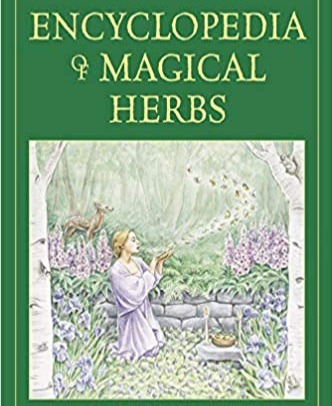
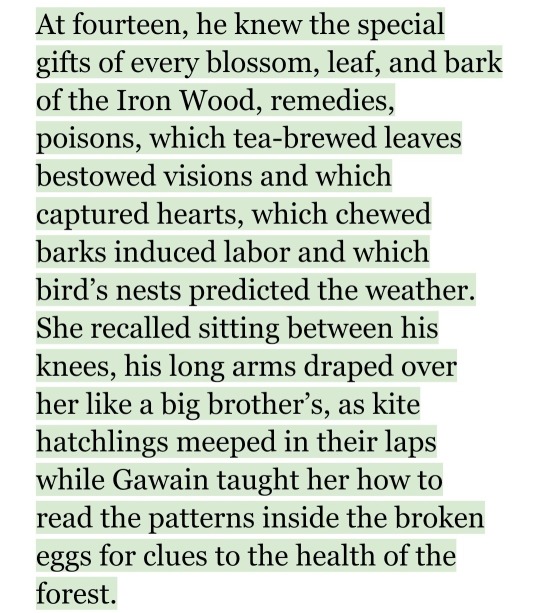

Despite the very jock-esque "charge in like a line-backer" brawn-over-brains soldier we see of Gawain in the 'Cursed' show, the book - through Nimue's memories at 7 years old of him as a youth growing up together in their village - permits us a glimpse of a vital additional facet to his character in the context of the 'Cursed'-verse. Before leaving his home of Dewdenn at 14 with little notice or explanation, 'Cursed's Gawain already had an extraordinarily deep connection with the Green. His innate knowledge & understanding of every aspect of nature - from tracking to weather prediction to herbal medicine & naturopathic magic - was profound enough even as a boy that it was he who taught Nimue most of what she knows about the forest.

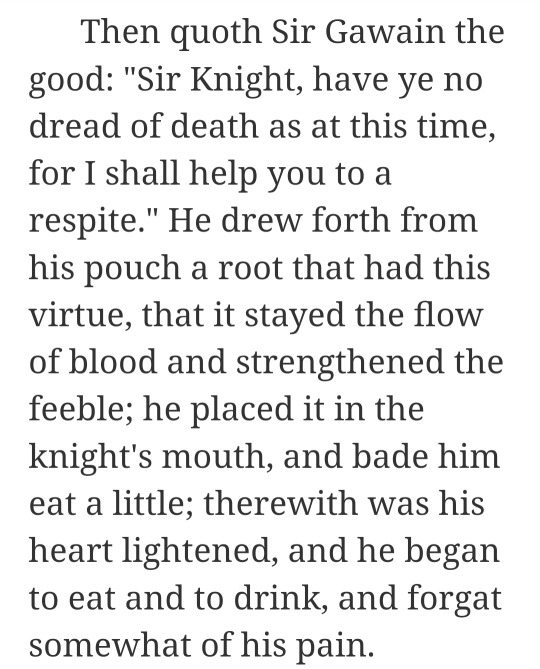
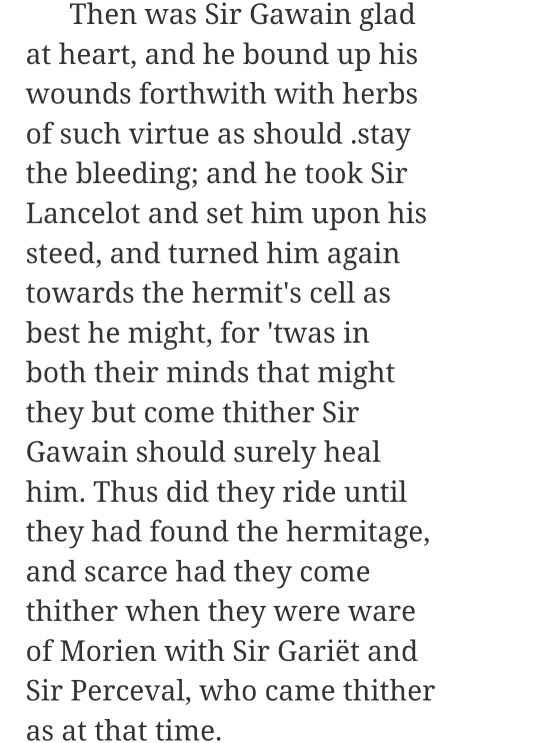
Gawain's Skill in Herbistry & Healing is actually a lore-established character trait firmly backed up in later Arthurian Tradition
It's mentioned in intermittently as far back as Chrétien's 'Perceval' & the Vulgate Lancelot-Grail cycle. It eventually became such a significant quality of him as character that the 13th Century Dutch poets expanded upon it, to the point of reinforcing references to his unparalleled skill in herbal medicine & wound triage repeatedly within the same tale. The above are just a couple of the many references to his ability as a Healer in the 13th Century poem of "Morien".
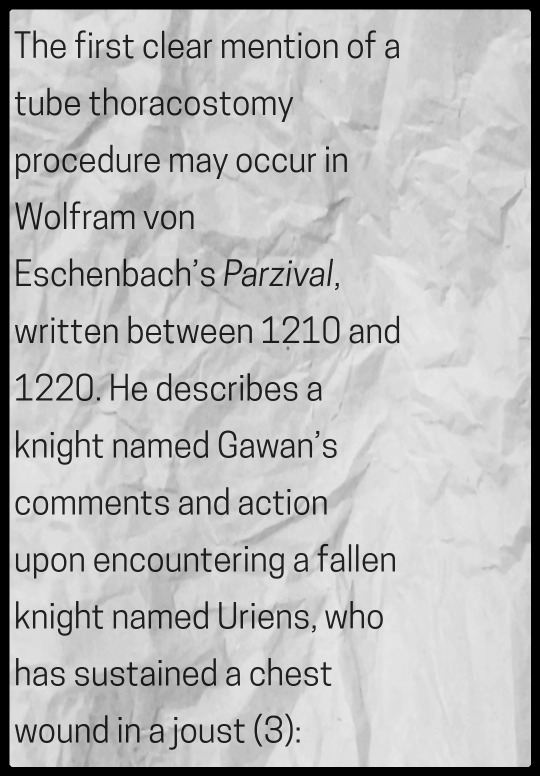


His talents at medicine even extended to triage field surgery.
The above passage from the 13th Century 'Parzival' is not only the first known literary description of a chest tube insertion, but it's an accurate summation of the procedure. While the tools we use today are of course different (sterile equipment & all that), 800 years later this is still pretty much exactly how we would treat a collapsed lung.
This is a man who, if not leading the life of a warrior, could have become the most gifted Physician of his time 😪
12 notes
·
View notes
Text
"Nimue...is like a Little Sister to me"
(Why Gawain "loved Lenore like a mother")
The only thing the 'Cursed' book clarifies about Gawain having boardedThe Brass Shield bound for the Desert Kingdom is that he'd left "home" in Dewdenn at only 14 (when Nimue was 7) with little-to-no notice and hardly a word of goodbye to anyone.
Very noticeably, no mention at all is made of him leaving birth parents behind in the Sky Folk village. The only familial-type connections mentioned are his stating referencing having loved Lenore "like a mother", as well as he & Nimue respectively referring to their thoughts of eachother as "like a little sister" & "like a big brother".
The fact that familial association is repeated suggests that particular connection may go deeper than Gawain's "all Fey are brothers" bit. Based on Traditional Arthurian Lore, even the way Wheeler & Miller like to turn the lore sideways, there's a better than average possibility they were hinting at Lenore & Jonah having raised him as a foster child.

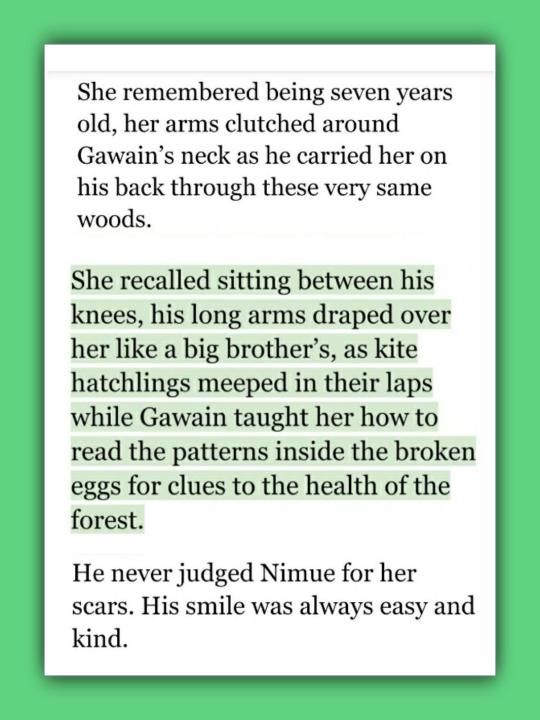
One of the common elements to most of Gawain's explored/developed origin stories in Arthurian Tradition (aside from the "Arthur's nephew" bit, but I'm not even gonna dare to dream of going there, because if 'Cursed' makes Gawain half Man Blood I will laugh until I cry 😂) that he grows up for his first 10-12 years as foster, with no clue his true parentage or that he's often heir to a Northern throne.
Those origin stories usually have him being abandoned in infancy by his young birth mother, usually due to illigitimacy at the time of his conception. Though she inevitably does end up marrying his high-born father, his parents are generally unaware he's even still alive to claim & legitimize.
So, child Gawain typically grows up with foster parents until roughly his pre-teens, whereupon he frequently learns that at least part of what he'd been raised to believe about where he came from is a lie.
At which point in the lore preteen Gawain usually says "screw who/where I came from, I'm going to become my own man!"
(Which somehow often involves him ending up in Byzantium [i.e. the Desert Kingdom]...unofficially adopted by the Holy Roman Emperor and/or the Pope, being trained as a young knight, then fighting in the Crusades...*side-eyes 'Cursed' & the Weeping Monk awkwardly*)
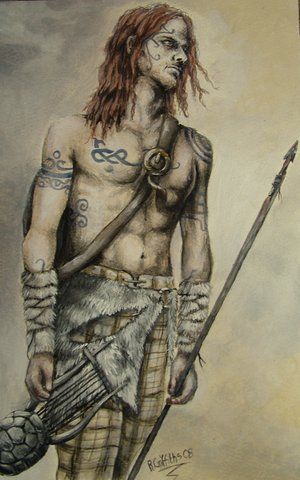

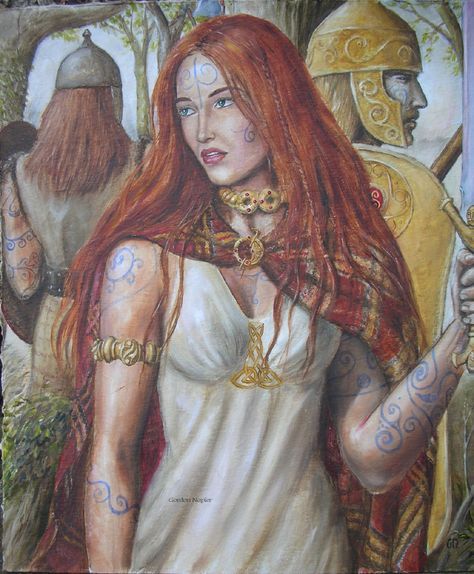
His biological father is usually Lot of Lothian and/or Orkney, often stated to be a ruler or King of the Picts.
His biological mother is most commonly known in the lore by the name Morgause, prior to that as Orcades. but after studying the etymology, both of these are most likely not a name but a title loosely translating to "Queen of Orkney". Monmouth names her as Anna, while later works called her Sangive and Seife.
But In the very earliest Arthurian legends mentioning him, under his original Welsh name 'Gwalchmei', his mother's name is given as 'Gwyar'.
Given Dewdenn's close proximity to Northern Wales in the show's map, for this fic-verse it seemed fitting to pay homage to those Welsh "ap Gwyar" roots as a bit of a kudos to Gawain's first confirmed known origins.
5 notes
·
View notes
Text
"It's those eyes...the mark of the Ash Folk..."

Aside from the red-headed boy in the first episode (whose Fey race is unknown) that Carden exposes with a Sycamore leaf & a brief mention in the book of Moon Wings being able to camouflage with tree bark, we don't see any other race of Fey beside the AshMan able to camouflage their skin to match the leaves of the Green. And that foliage-chameleon ability doesn't seem to be something that requires conscious effort to tap into. Quite the opposite, in both cases it seems to be instinctively something they can't prevent themselves from doing, at least not without considerable control; control which is probably significant frayed under stress (the child's fear & the Monk's injury).
You'd think that if they other races like the Sky People had that type of ability to camouflage themselves in the Green, they'd use it to hide from & evade Fey-hunters like the Paladins. Especially, for instance, Squirrel when he's hiding in the Iron Wood after the pillaging of Dewdenn. If it's - as it appears to be - not only an ability but also an instinctive defensive fight-or-flight stress response, the trauma of what Squirrel's just been through & his visible fear would make him almost certainly unable to not camouflage amidst the forest. The 'Fingers of Airimid' that climb vine-like up Sky Folk's features when working with the Hidden seems to be the closest they can pull off, but that's not even remotely close to fully disguising their skin to blend against the Green.
Meaning it doesn't appear to be a general Fey characteristic as much as a clan-specific ability. Indicating Lancelot's Ash Folk in particular have a specific connection to plants & The Green.
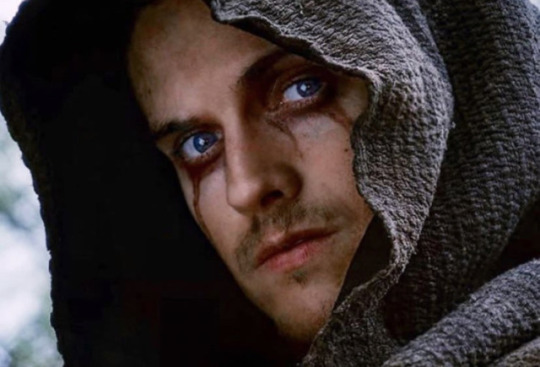
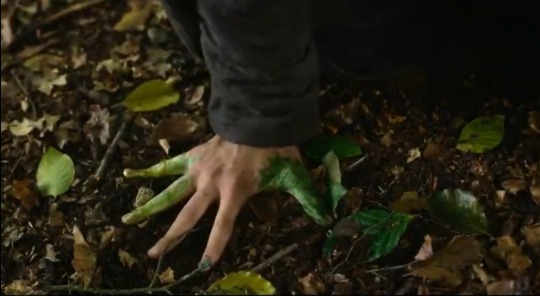
We see The Weeping Monk in the forest & touching plant life often, from nearly the beginning, without his skin reacting, so why is the fight with Gawain different? Is it merely that his control over the camouflage ability to suppress the change of his skin is weakened by the exertion of combat & the Green Knight's slash to that arm? He takes advantage of Gawain's distraction, but in both the book & show Lancelot's violent takedown smacks of fear & anger at his secret nature being exposed; he very much did not mean for that to be seen.
(acknowledgement: In the book, it's moss that his hand camouflages against; the following details seem to be a connection developed & expanded upon later by/for the show canon)
The Weeping Monk's slip of control may be more significant than injury or exertion. If you take note of the forest the climactic combat takes place in, Lancelot & Gawain are fighting in a woodland grove of European Ash Trees. And the fallen leaves he's touching when his hand begins to take on the forest camouflage are - in fact - specifically Ash leaflets.
Of all the times throughout the series where he touches plant life without a reaction, only one other scene shows him touch what looks to be an Ash Tree. The trees he discovers the Fey Sign directing towards Nemos Sanctuary also appear to be Ash; he lays his hand against an Ash trunk beside the Fey Sign & just holds it their a moment - almost reverently or searchingly, quite differently then when he touches blood or fabric on other leaves & branches & vines while tracking - but his hand remains hidden from view while he does so, leaving open the possibility that it camouflages against the bark where no one (other than Carden, who knows his secret) can see.

Perhaps the distinctive Ash Folk facial markings are akin to the Fey equivalent of the monarch-like patterns of the 'Tree Nymph' Butterfly?
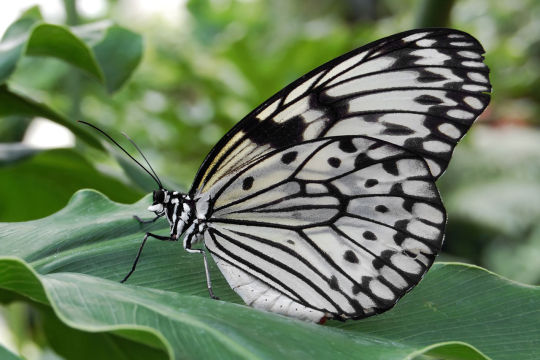
In nature, those markings are typically a biological warning to predators that the butterfly species who bear them are "toxic if eaten", a clear message to any creature wanting to make a meal of it that said creature will die with it.
The Weeping Monk's markings do seem varying degrees of both darker & more solid in scenes when he's in active Hunter-Killer-Murder-Mode or when he feels in danger like going to see Gawain - who even tied up & tortured poses a frightening risk to him because of knowing his secret - in Brother Salt's Kitchen. Yet they not only fade in color but seem to take on an almost hollowed insubstantial texture when surrounded by or alone with those who he feels pose him no threat, such as at Yvoire Abbey or whenever he's alone with Squirrel.
Could they be the Ash Folk's instictive biological signal to predators to back off - darkening angrily as a reminder of his lethality like a rattlesnake's warning before striking?
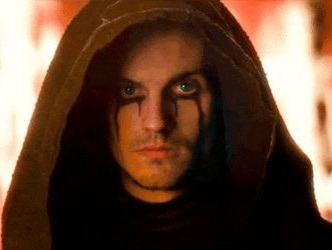
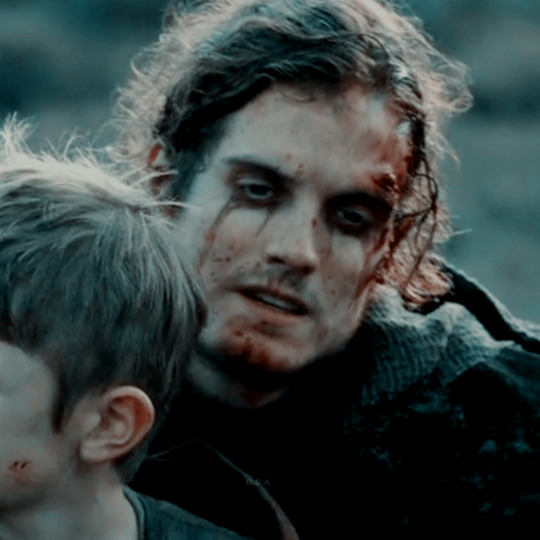
Or, consider that after touching the Ash Leaves, when returning to the Paladin camp not only are his markings darker & fuller but his whole complexion is visibly darkened/bronzed to a degree that makes his paleness talking alone with Father later look sickly in comparison.
Perhaps their scar-like texturized appearance is akin to that of veins on a leaf? Perhaps both his markings & his overall skin-tone darken subtly in the woods (consequently, also usually where he's fighting/killing) to reflect being healthier & more vibrant when opening himself up to The Green, but appear palid & drained when he tries to force himself to conform to the Man Blood world & cuts himself off from his true nature?
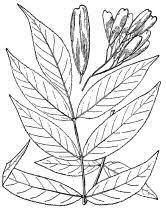
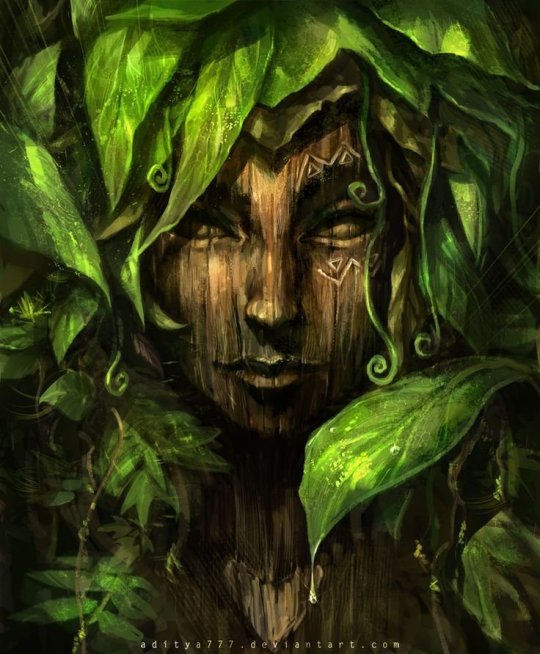
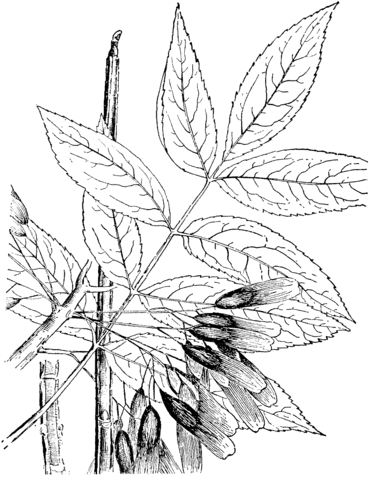
Mind you...I still very much am on the fan-theory bandwagon that Fey Fire will turn out to be tied to the Ash Folk & Lancelot himself, but considering exactly what kind of leaf he's touching when his skin changes I also speculate that not being where the Name of his Clan comes from. I'm fairy certain his Fey tribes are called "Ash Folk" because they are - in fact - legit Ash Tree Wood Nymphs, descended from the Meliae subspecies of Dryads in Greek Mythology 🌿 Which almost makes Carden having him burning down the forests even more fucked up than it already was 🙄
(Art not mine, credit goes to Aditya Ikranegara at DeviantArt)
5 notes
·
View notes
Text
"CURSED" Characters' Age Breakdown (per the book)
Squirrel: 10 years old
Iris: 11 years old
Pym: 16
Nimue: 16
Gawain: 23 (see discussion below)
Uther Pendragon: 26
Arthur: age unspecified, likely 25-26 (see discussion below)
Lancelot: age unspecified, presumably same age range as Gawain & Arthur & Uther (to be discussed in more detail at a later date)
Morgana: age unspecified, likely 21-24 (she's stated in the book by Arthur to be 2 years younger than him, but he's an unreliable narrator about his past so that might be unreliable as well...see discussion below)
DISCUSSION/Explanation of Questionable and/or Speculated Ages
Gawain: Okay, so, the book expressly states him to be "7 years older" than Nimue & have left Dewdenn "at age 14", specifying his departure as having been 9 years before the story itself takes place (Nimue is confirmed several times in the book to be 16 - almost 17). And despite the fact that actor Matt Stokoe (29-30 at time of filming) does not pull off passing for early-mid 20s the way his costars do (IRL he's a few years younger than Daniel Sharman who played The Weeping Monk / Lancelot & only two years older than Devon Terrell who played Arthur), that's something I'm willing to suspend my disbelief on & mentally compartmentalize as "world-weariness & war have taken a toll & 'aged' him beyond his years". In part because, looking back at some of his roles several years ago, the actor looked damn near 30 when he was 23. My own ex looked at age 24 (when I met him) older than Stokoe does now, I've got a friend who looked mid-30s at age 19, I have old photos of my mother at age 13 where she looked completely indistinguishable from her wedding pictures at 23 or her nursing school graduation pictures at 27 & I myself was consistently mistaken for my mid-20s by the time I was 14. The classic "Gawain" hairstyle also does him no favors; there's a scene very early on in his introduction, when he & Nimue are alone in one of the caverns discussing the Sword & Merlin, where he's freshly clean shaven with his hair pulled back away from his face in a ponytail & while he still doesn't look 23 he does look considerably younger than in any other scene in the series. (I genuinely think that production was just kind of oblivious - with 34 year old Daniel Sharman so easily passing for a decade younger - to the fact Matt Stokoe was not 'reading' early-mid 20s the way his costars do). But more pointedly, in the context of 'Cursed', Arthur's fear of loosing Nimue to Gawain is played out only as jealousy directed at a perceived rival for her affection. Regardless of which one's responses & behaviors to other situations present as mature vs childish, they very expressly interact with eachother behaviorally as rivals & contemporaries, NOT like a youth vs an older adult (in fact, Gawain behaves markedly immaturely around/toward Arthur - on pretty much every level - up until Moycraig). They even choreographed the majority of Gawain's/Arthur's postures & movements to mirror eachother from their 2nd scene together onward, to draw a cinematic visual parallel between them from the very beginning. I think if Gawain being considerably older had been an intentional/conscious change on the part of the show, the dynamic of their relationship wouldn't have been staged so specifically to mirror eachother to such an extent.
Arthur: Now, that being said, even though the book doesn't specify I strongly suspect book-Arthur himself to be canonically no younger than 25. Reason being, in the Arthuriana Tradition, Arthur unknowingly being a Pendragon bastard or secret offspring is one of the single most consistent themes throughout centuries of varying lore, hand in hand with the magic Sword, for his claim to the throne. And the book does have him expressly introduce Morgana as his younger half-sister, which not only suggests same mother with different father but also that despite Arthur having been raised by him they know he's not biologically Sir Tor's (although Arthur thinks of him as such). Now, 'Cursed' is obviously forgoing the traditional lore of Arthur being Uther's illegitimate son, because no matter how you slice it Uther's too young to have fathered him even if you aged show-Uther up a decade+ from the book's specified 26 years old & aged Arthur down a bit. But beyond that, they've thrown in the added touch of Uther himself - having been secretly switched at birth for Queen Lunette's still-born son - not in fact being the previous king's true-born heir. Once the Sword passes eventually to Arthur, even with legends about "he who wields the sword will be the true king", Man Blood society will require more than prophecy to recognize/legitimize a his rulership. Though strictly speculation, if I had to make a prediction about Book/Season 2, it would be on Merlin or someone else uncovering evidence that Arthur's actually the previous king's illegitimate biological son rather than his "father" Sir Tor's - conceived shortly before the old king's death sometime during Queen Lunette's pregnancy - at a guess that evidence coming from either Arthur's aunt or uncle. I figure that evidence will wind up being publicly recognized/acknowledged as part of the climax of a redemption/growth arch for Uther, naming Arthur his "brother/heir", prior to his own death - giving Arthur a legitimate claim on the Pendragon throne that supercedes Cumber's claim as a Pendragon cousin. If I'm right in that prediction, since the old King had died by the time Uther was born, Arthur can be no more than 9 months younger than 26 year old Uther, making him at least 25. (It's debated within the fandom that he doesn't look or act like the character is out of his late teens, but considering the actor himself is 28, I'm really not sure how that's defined? Appearance-wise he's got more chest hair on display with his doublet on than Lancelot does with shirt off & his immature avoidance of responsibility seems from the book to be more reflective of subconsciously modeling Tor's example than an age indicator but he's old enough he's spent several years already as a sword-for-hire mercenary. So, while I do allow my theory in his parentage & age is speculation which Book/Season 2 may prive me completely wrong able - not ratified canon - I do stand by that theory for my fic-verse; how old someone "looks" is really subjective & debatable, plus if "maturity level" was meant to be any kind of concrete age indicator in the Cursed-verse then King Uther wouldn't spend the entire series & book acting like a spoiled 6 year old.)
[The following doesn't change anything about how old I think Arthur himself is, but creates some potential flexibility regarding Morgana's age: When Arthur's reflecting on memories of childhood - even via internal monolog - he's consistently inconsistent regarding what age he claims to have been for key noted childhood events (at one point in his thoughts he recalls being 16 with his living mother away tending to a sick relative when Tor died, but later on in the book he reflects that he'd been 10 when Morgana was sent away to Yvoire Convent after he inherited all of Sir Tor's debt with presumably no living mother around to prevent it; alternatively, the show specified he was age 12 when Tor died & Morgana was sent away). At first I thought it was a total screw-up in the writing, but then I reread Morgana's repeated characterization of him as inconsistent & flighty & self-serving & utterly full of shit, paired with Arthur's own characterization of Tor (who again, I don't think was his biological father but was certainly his most formative male role-model) as quite literally talking out of his ass about his imaginary exploits pretty much 100% of the time & Arthur himself repeatedly bending the truth to get what he wants as an ingrained survival habit consistently seen via interaction with people like Bors & Druuna. Again, this is purely speculation, but I think it his written contradictory self-reflections were probably very much on purpose to intentionally establish him as a starting off a significantly "unreliable narrator" the same way he recalls Tor being, to the point of lying to himself rather than deal with painful memories or take accountability/responsibility for uncomfortable personal flaws & faults. I suspect that him overcoming that tendency that he learned from Tor's example - with actions like admitting to Nimue he was in the wrong going after the first man he ever killed (mistakenly believing him to be one of those responsible for Tor's death) shaming his father's memory & like coming back to fight with/for the Fey - are going to be a driving feature within his growth/redemption arch in Book/Season 2.]
Morgana: The book specifies Arthur telling Nimue that Morgana is 2 years his junior; however, he establishes himself as such an unreliable narrator that I feel like anything he says about him & Morgana that's not directly corroborated by Morgana herself is suspect, even their age difference, so I'll allow for the possibility of the age gap potentially being up to 4 years instead of 2. If my guess (see above) about Arthur's paternity - therefore his age - is correct, that puts Morgana herself somewhere between 21 -24. Per societal norms of the period, that actually puts her into "old maid" territory, but contextually to the historical era, she would have been able to get away with dodging societal pressure of being married off against her wishes by that age - up until leaving the abbey at least - because of having been at convent (in contrast to 16 year old Pym, who in both the book & the show says her mother's trying to force her into an unwanted marriage to "Stinky Aaron" the human fish-wife's son).
(note: I compiled this mostly as a quick reference citation I can direct myself or my fic readers back to for my 'canon' logic on the ages I've assigned characters in my stories. I went with the ages listed in the book for my fic-verse because of the express lack of clarification of most of them given in the show & am speculating on the others based on lore-related theory, so yes the potentially problematic age difference is present. I don't intend to villainize Arthur over having pursued her, partially because even though the readers know she's 16 there's nothing in the book & only one brief comment from Gawain in the show which isn't followed up on - Ector calling her a child doesn't count because he dismisses all of them as children - to indicate that Arthur knows she's that young & many contextual reasons for him to have assumed she was older. I apologize if that offends, but it's not meant as an endorsement of it; as the story outline/concept for this fic-verse stands I have no plans on romantically pairing Nimue with anyone & no plans for Pym so soon after Dof's death to be seriously looking at anyone in that capacity until much later in the story.)
4 notes
·
View notes
Text
PINNED (INTRO & DISCLAIMERS)
(Scroll Down For New Content)
The purpose of this side-Blog is going to be - predominantly - to serve as a Codex/Appendix of sorts for my Cursed-verse fanfiction on AO3.


Because I tend to run off at the mouth & get a kick out of explaining or discussing my inspirations for plot decisions, more often than not citations within the story will probably link back to refence posts here rather than eat up 1K words of Author's End Notes 😜
Aside from - of course - chapter updates for my existing/ongoing Cursed-verse series & potentially a prequel character/clan origins series or series-adjacent Cursed-verse works, it will (hopefully) included visual references/inspirations for original/borrowed characters & locations 😁
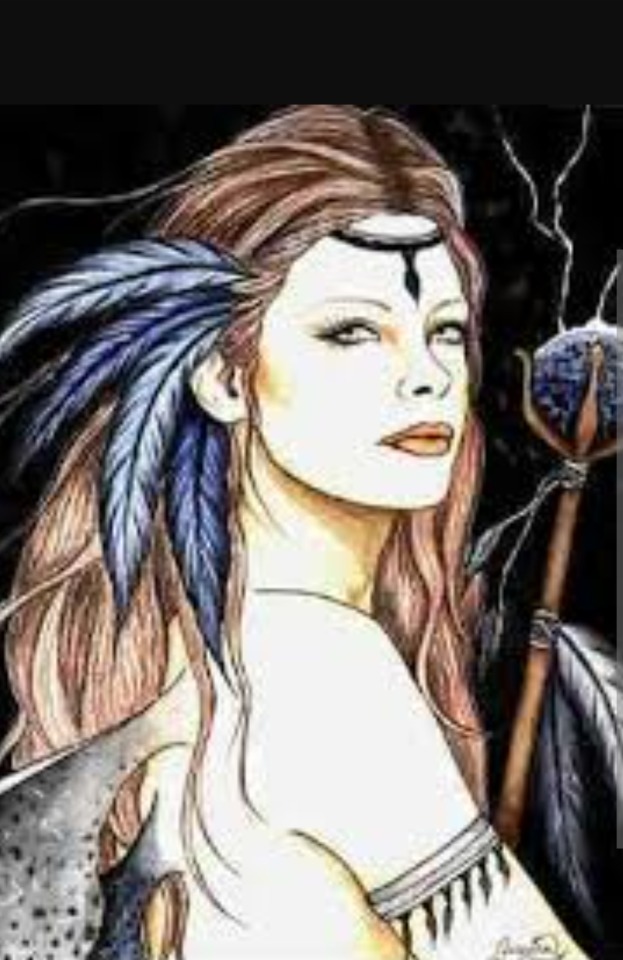
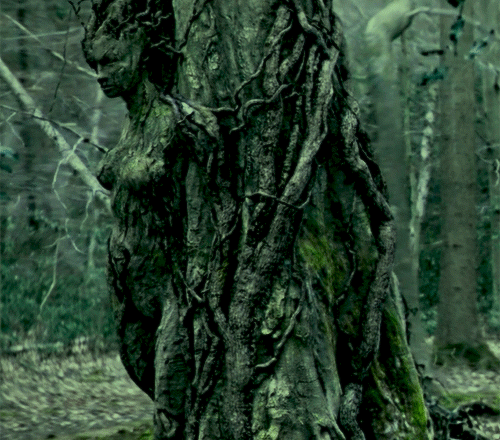


Additionally, I'll be trying to include reference information discussing drawing some of my inspiration for world-building personal charactor backstories, as well as for both character & clan origin concepts and/or theories, from established Traditional Lore & existing texts pertaining to Brythonic (Welsh, Cornish & Breton) & Goidelic (Irish/Scottish) & Romano-British & even Greek mythology where applicable. I'll also, however, be "creatively re-interpreting" some of it in my how I apply it within the stories. I very much don't wish to misrepresent the lore or religious mythologies I'm drawing from or try to pass off my "creative re-imagining" as religiously 'canon', so I'll try to clarify with citations of some sort what texts I'm referencing my inspiration from vs what I'm putting my own spin on (or just flat-out making up, as the case may be) for plot purposes.

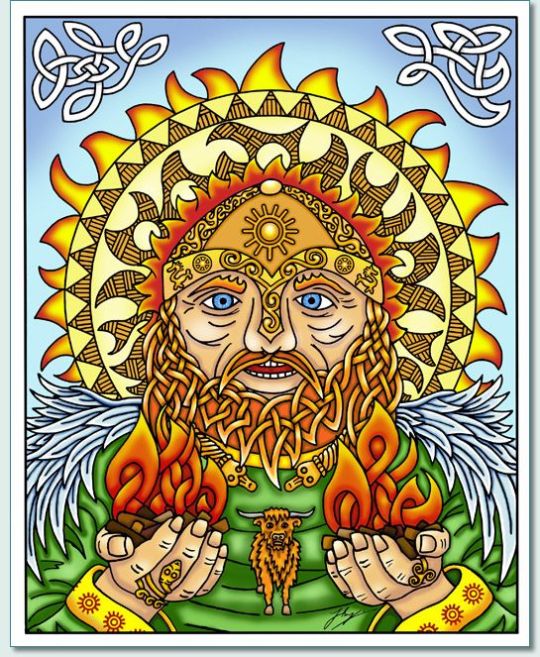
[To Be Clear: Although several of the texts I'm drawing from are core mythologies from my own religious practice & study, my appropriation - and/or MISappropriation - of them for my Cursed-verse fics are intended as my own personal HEAD-CANON for the STORIES only, NOT as a real-world treatise on "this is how You (or I) Pagan". Nor is it an endorsement of some of the offensive content within the texts themselves; the fact is, however, that Arthuriana Lore, as well as myth-cycle texts like both the 'Cath Maighe Tuireadh' & the 'Mabinogion', are rife with things like incest & infanticide & some really dubious consent that I don't plan on censoring out when applying their themes to my world-building. I welcome discussion of those themes & their context within the story, though. That being said, I do NOT welcome commentary expressing REAL-WORLD homophobia, xenophobia, racism, ableism, criticism of gender identity expression or mental health issues, etc. Messages/replies endorsing that agenda on a personal level won't be tolerated; take that happy horseshit to someone who will cosign that bigoted crap, but it ain't gonna be me.]

It will also include observations I've noted on references Wheeler & Miller seem to have made in both/either/or the illustrated novelization & the Netflix Series - not only to both common & obscure Arthuriana, but also to historical as well as religious/mythological & scientific/medical & even sociopolitical references - along with my interpretation of those references.
[Please note: I do NOT presume to speak for the authors as to their intent of what's canon unless I'm quoting them or 'Cursed' (book or show) directly! Aside from specifying the reference they've made & citing the source material I think they drew their inspiration from, what I think that Wheeler & Miller intended to imply with it is USUALLY purely my own SPECULATION. It's not a claim to be the all-or-nothing voice of Fandom 'canon', nor are my speculations/predictions or personal head-canon for my own fic-verse intended to subvert/displace the personal head-canons or interpretations of other fic authors within the fandom when it comes to their own works.] [Although I do love the fact that some of us seem to be evolving - through discussions & mutual appreciation of eachother's input/ideas - a kind of interwoven or complementary fic-verse 'fanon' 🥰]
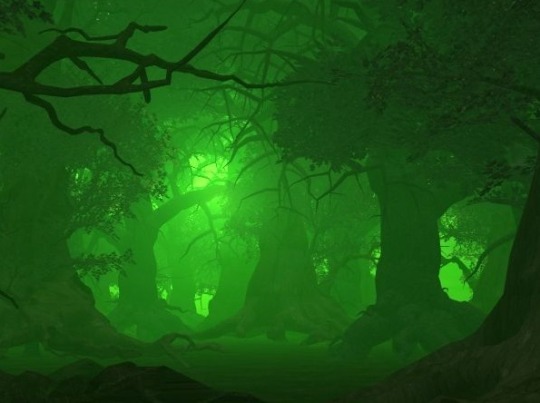
2 notes
·
View notes